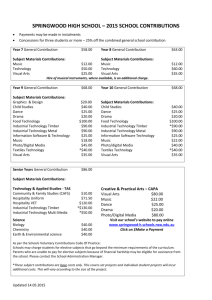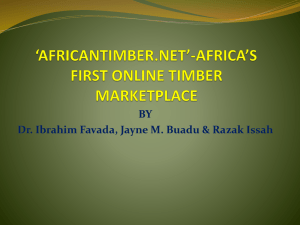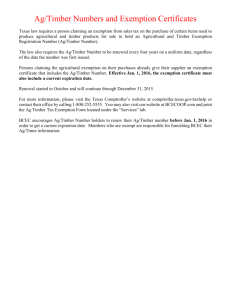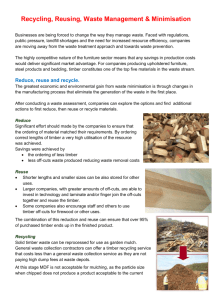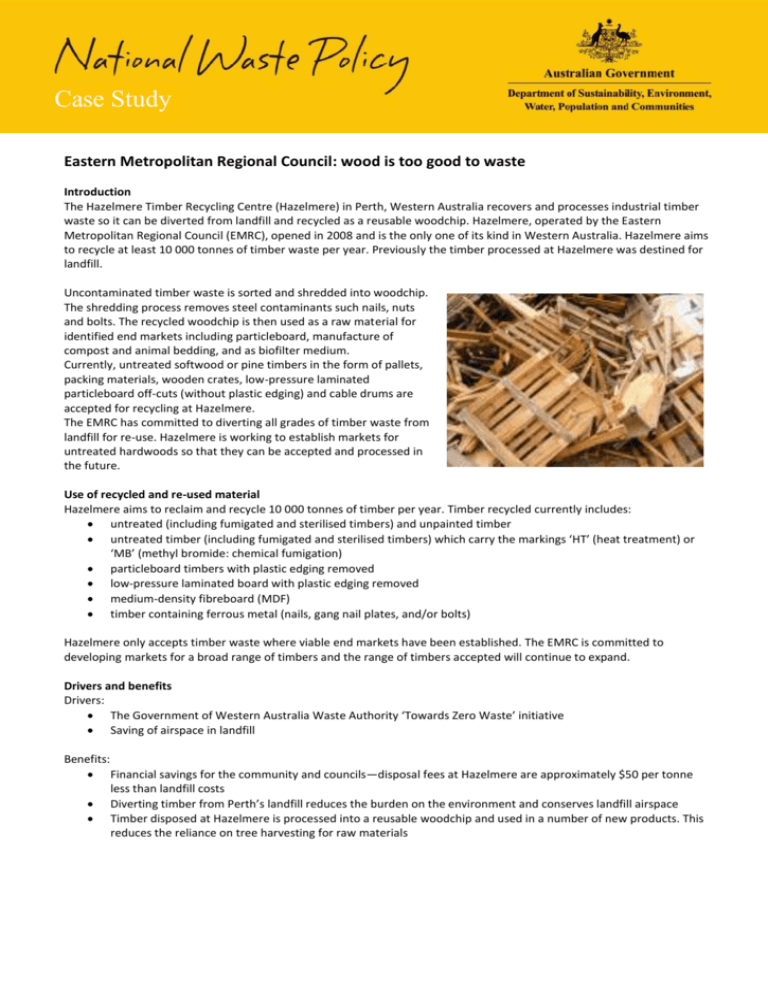
Case Study
Eastern Metropolitan Regional Council: wood is too good to waste
Introduction
The Hazelmere Timber Recycling Centre (Hazelmere) in Perth, Western Australia recovers and processes industrial timber
waste so it can be diverted from landfill and recycled as a reusable woodchip. Hazelmere, operated by the Eastern
Metropolitan Regional Council (EMRC), opened in 2008 and is the only one of its kind in Western Australia. Hazelmere aims
to recycle at least 10 000 tonnes of timber waste per year. Previously the timber processed at Hazelmere was destined for
landfill.
Uncontaminated timber waste is sorted and shredded into woodchip.
The shredding process removes steel contaminants such nails, nuts
and bolts. The recycled woodchip is then used as a raw material for
identified end markets including particleboard, manufacture of
compost and animal bedding, and as biofilter medium.
Currently, untreated softwood or pine timbers in the form of pallets,
packing materials, wooden crates, low-pressure laminated
particleboard off-cuts (without plastic edging) and cable drums are
accepted for recycling at Hazelmere.
The EMRC has committed to diverting all grades of timber waste from
landfill for re-use. Hazelmere is working to establish markets for
untreated hardwoods so that they can be accepted and processed in
the future.
Use of recycled and re-used material
Hazelmere aims to reclaim and recycle 10 000 tonnes of timber per year. Timber recycled currently includes:
untreated (including fumigated and sterilised timbers) and unpainted timber
untreated timber (including fumigated and sterilised timbers) which carry the markings ‘HT’ (heat treatment) or
‘MB’ (methyl bromide: chemical fumigation)
particleboard timbers with plastic edging removed
low-pressure laminated board with plastic edging removed
medium-density fibreboard (MDF)
timber containing ferrous metal (nails, gang nail plates, and/or bolts)
Hazelmere only accepts timber waste where viable end markets have been established. The EMRC is committed to
developing markets for a broad range of timbers and the range of timbers accepted will continue to expand.
Drivers and benefits
Drivers:
The Government of Western Australia Waste Authority ‘Towards Zero Waste’ initiative
Saving of airspace in landfill
Benefits:
Financial savings for the community and councils—disposal fees at Hazelmere are approximately $50 per tonne
less than landfill costs
Diverting timber from Perth’s landfill reduces the burden on the environment and conserves landfill airspace
Timber disposed at Hazelmere is processed into a reusable woodchip and used in a number of new products. This
reduces the reliance on tree harvesting for raw materials
Problems and challenges
Contamination is the main challenge when recycling timber from mixed
waste. Contamination in the form of rags, plastic, strapping, and
construction waste, (such as concrete) wraps around processing
equipment and causes damage to machinery. Contamination in the
form of aluminium (such as drink cans), rocks and limestone carries
through into the final product which means that market specifications
cannot be met. Timber treated with copper chromium arsenic and
household waste causes environmental issues when grinding and poses
a safety risk to animals when re-used. Contamination in the form of
high pressure laminate affects processing as it is too hard and abrasive
to break down into a reusable size.
Solutions
Hazelmere staff work hard to identify contamination at the gates, and are constantly looking for more efficient methods of
identifying and removing contamination to improve the production process.
A price incentive is given at the gate: mixed loads with potential contamination are more expensive.
Educating and engaging the public is an ongoing initiative—pamphlets, handouts and signage outline Hazelmere’s
operation and achievements.
The ultimate solution would be segregation of wastes at source, allowing a clean stream of timber waste to be recycled.
The timber industry is working on this, establishing the National Timber Product Stewardship Group in 2007 to address
these types of issues.
Opportunities for other projects
On 6 April 2011 the EMRC officially opened a fully automated wood grinding plant at Hazelmere, which is designed to
recycle 20 tonnes of wood waste per hour. HAAS-Recycling (Germany) designed and manufactured the plant which turns
waste wood usually destined for landfill into two separate streams of chipped and cleaned products that EMRC sells as
animal bedding and for particleboard manufacturing.
If markets for treated timber could be found, this case study shows an opportunity to recycle and re-use a new type of
timber resource. The industry requires research into markets for treated timber
waste.
Contacts and links
Timber Product Stewardship Group
www.timberstewardship.org.au
Eastern Metropolitan Regional Council’s Hazelmere Timber Recycling Centre
http://www.emrc.org.au/hazelmere-recycling-centre
Consultation
Johan Leroux, Manager, Eastern Metropolitan Regional Council
Photos
Courtesy of Hazelmere Recycling Centre
© Commonwealth of Australia 2011
This work is copyright. You may download, display, print and reproduce this
material in unaltered form only (retaining this notice) for your personal, noncommercial use or use within your organisation. Apart from any use as permitted
under the Copyright Act 1968, all other rights are reserved. Requests and enquiries
concerning reproduction and rights should be addressed to Department of
Sustainability, Environment, Water, Populations and Communities, Public Affairs,
GPO Box 787 Canberra ACT 2601 or email public.affairs@environment.gov.au
The views and opinions expressed in this publication are those of the authors and
do not necessarily reflect those of the Australian Government or the Minister for
Sustainability, Environment, Water, Population and Communities.
While reasonable efforts have been made to ensure that the contents of this
publication are factually correct, the Commonwealth does not accept responsibility
for the accuracy or completeness of the contents, and shall not be liable for any loss
or damage that may be occasioned directly or indirectly through the use of, or
reliance on, the contents of this publication.




